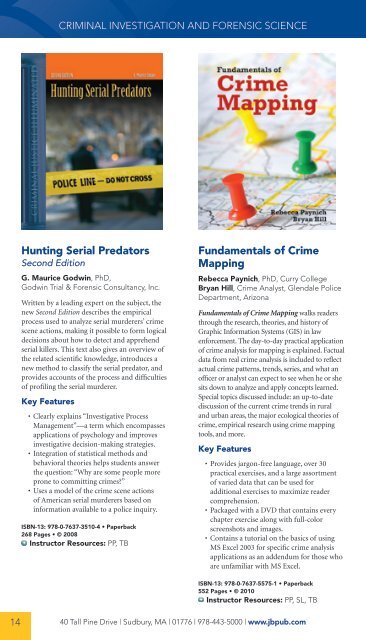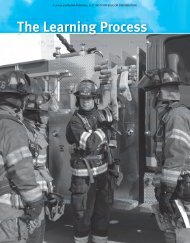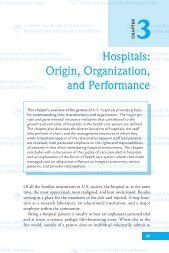Criminal Justice 2010.pdf - Jones & Bartlett Learning
Criminal Justice 2010.pdf - Jones & Bartlett Learning
Criminal Justice 2010.pdf - Jones & Bartlett Learning
You also want an ePaper? Increase the reach of your titles
YUMPU automatically turns print PDFs into web optimized ePapers that Google loves.
CRIMINAL INVESTIGATION AND FORENSIC SCIENCE<br />
Hunting Serial Predators<br />
Second Edition<br />
G. Maurice Godwin, PhD,<br />
Godwin Trial & Forensic Consultancy, Inc.<br />
Written by a leading expert on the subject, the<br />
new Second Edition describes the empirical<br />
process used to analyze serial murderers’ crime<br />
scene actions, making it possible to form logical<br />
decisions about how to detect and apprehend<br />
serial killers. This text also gives an overview of<br />
the related scientific knowledge, introduces a<br />
new method to classify the serial predator, and<br />
provides accounts of the process and difficulties<br />
of profiling the serial murderer.<br />
Key Features<br />
• Clearly explains “Investigative Process<br />
Management”—a term which encompasses<br />
applications of psychology and improves<br />
investigative decision-making strategies.<br />
• Integration of statistical methods and<br />
behavioral theories helps students answer<br />
the question: “Why are some people more<br />
prone to committing crimes?”<br />
• Uses a model of the crime scene actions<br />
of American serial murderers based on<br />
information available to a police inquiry.<br />
ISBN-13: 978-0-7637-3510-4 • Paperback<br />
268 Pages • © 2008<br />
Instructor Resources: PP, TB<br />
Fundamentals of Crime<br />
Mapping<br />
Rebecca Paynich, PhD, Curry College<br />
Bryan Hill, Crime Analyst, Glendale Police<br />
Department, Arizona<br />
Fundamentals of Crime Mapping walks readers<br />
through the research, theories, and history of<br />
Graphic Information Systems (GIS) in law<br />
enforcement. The day-to-day practical application<br />
of crime analysis for mapping is explained. Factual<br />
data from real crime analysis is included to reflect<br />
actual crime patterns, trends, series, and what an<br />
officer or analyst can expect to see when he or she<br />
sits down to analyze and apply concepts learned.<br />
Special topics discussed include: an up-to-date<br />
discussion of the current crime trends in rural<br />
and urban areas, the major ecological theories of<br />
crime, empirical research using crime mapping<br />
tools, and more.<br />
Key Features<br />
• Provides jargon-free language, over 30<br />
practical exercises, and a large assortment<br />
of varied data that can be used for<br />
additional exercises to maximize reader<br />
comprehension.<br />
• Packaged with a DVD that contains every<br />
chapter exercise along with full-color<br />
screenshots and images.<br />
• Contains a tutorial on the basics of using<br />
MS Excel 2003 for specific crime analysis<br />
applications as an addendum for those who<br />
are unfamiliar with MS Excel.<br />
ISBN-13: 978-0-7637-5575-1 • Paperback<br />
552 Pages • © 2010<br />
Instructor Resources: PP, SL, TB<br />
14<br />
40 Tall Pine Drive | Sudbury, MA | 01776 | 978-443-5000 | www.jbpub.com

















